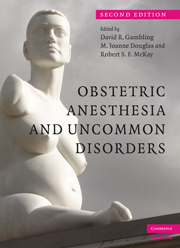Book contents
- Frontmatter
- Contents
- List of plates
- List of contributors
- Preface
- Section 1 Cardiovascular and respiratory disorders
- Section 2 Musculoskeletal disorders
- 5 Myopathies
- 6 Parturients of short stature
- 7 Disorders of the vertebral column
- 8 Miscellaneous skeletal and connective tissue disorders in pregnancy
- Section 3 Nervous system disorders
- Section 4 Metabolic disorders
- Section 5 Other disorders
- Index
- Plate Section
- References
5 - Myopathies
from Section 2 - Musculoskeletal disorders
Published online by Cambridge University Press: 19 October 2009
- Frontmatter
- Contents
- List of plates
- List of contributors
- Preface
- Section 1 Cardiovascular and respiratory disorders
- Section 2 Musculoskeletal disorders
- 5 Myopathies
- 6 Parturients of short stature
- 7 Disorders of the vertebral column
- 8 Miscellaneous skeletal and connective tissue disorders in pregnancy
- Section 3 Nervous system disorders
- Section 4 Metabolic disorders
- Section 5 Other disorders
- Index
- Plate Section
- References
Summary
Introduction
Myopathies are diseases of the skeletal muscle cell with intact innervation. The hereditary myopathies are the muscular dystrophies, congenital myopathies, metabolic myopathies, inflammatory myopathies, and disorders of muscle membrane excitability. Pregnant women with a myopathy have specific needs depending on the symptoms and severity of the disease. Exacerbation of muscle weakness is common, especially in the third trimester. This decreased muscle strength may not be able to compensate for the high demands of labor and delivery. Pregnancy may occasionally uncover a disease that was previously asymptomatic. Multidisciplinary consultation early in the pregnancy is important for a successful outcome.
Hereditary myopathies (see Table 5.1)
Muscular dystrophy
Muscular dystrophy is a major cause of progressive weakness and wasting of the musculature of the limbs and trunk. It usually can be differentiated from a neuropathy by the involvement of the proximal muscle, the absence of sensory disturbances, and abnormalities of the electromyogram, muscle biopsy, and DNA studies. Muscular dystrophies are the result of a primary genetic defect, which is specific to each type. Inheritance is due to a dominant, a recessive, or a sex-linked gene, or a muscular dystrophy may arise by the occurrence of a mutation. Classification is based on historic descriptions or clinical similarities. Since oculopharyngeal dystrophy has an onset in the fifth or sixth decade it will not be discussed here.
Duchenne, Becker, and Emery-Dreifuss muscular dystrophies
Duchenne, Becker, and Emery-Dreifuss muscular dystrophies are sex-linked disorders affecting males and they are now classified as dystrophinopathies.
- Type
- Chapter
- Information
- Obstetric Anesthesia and Uncommon Disorders , pp. 101 - 114Publisher: Cambridge University PressPrint publication year: 2008
References
- 2
- Cited by



